Notes
Question by Topic
Notes
This page contains the detailed and easy notes for GCSE Edexcel Chemistry Rates of Reaction and Energy Changes for revision and understanding Rates of Reaction and Energy Changes.
Banner 1GCSE Edexcel Rates of Reaction and Energy Changes Complete Revision Summary
Rates of Reaction and Energy Changes
Banner 2Rates of Reaction and Energy Changes
- Exothermic Reactions
- Endothermic Reactions
- Reaction Profile Diagrams
- Bond Energy Calculations
- Fuel Cells
- The Rate of reaction
- Factors Affecting Rates of Reaction
- Collision Theory
- Catalysts
- Reversible Reaction
- Dynamic Equilibrium
- Altering Conditions
TYPES OF REACTIONS
Law of conservation of energy states that energy is neither created nor destroyed. It just converts from one form to another.| Exothermic Reactions | ENDOTHERMIC REACTIONS |
| Reactions that releases heat to the surroundings. | Reactions that takes in heat from the surroundings |
| The reaction is accompanied by increase in temperature of the surroundings as the heat is released. | The reaction is accompanied by decrease in temperature of the surroundings as the heat is absorbed. |
| The product have the lower energy than the reactants. | The products have higher energy than the reactants. |
| Example: Combustion reaction and Respiration | Example: Thermal decomposition and -Photosynthesis |
| In terms of bond breaking the energy released in making the product is more than energy used up in breaking the reactants. | In terms of bond breaking the energy used in breaking the bonds of reactants is more than the energy released in making up of the products. |
| Used in self heating cans and hand warmers | Used in Ice packs made for sports injuries |
REACTION PROFILE DIAGRAM
Exothermic Reaction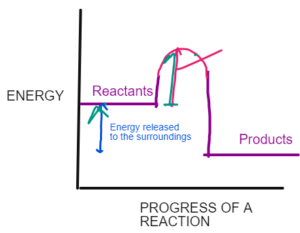
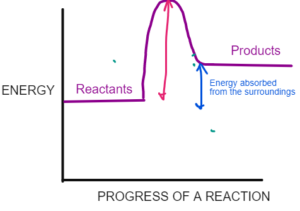 Defining Exothermic and Endothermic in terms of Bond making and Breaking
Defining Exothermic and Endothermic in terms of Bond making and Breaking
| Reactants | Products | ||
| Bonds are always broken in a reaction | Bonds are always made in a reaction. | ||
| Endothermic | Breaking of bonds of the reaction takes in heat | > | Making of bonds of the products Releases heat. |
| Exothermic | Breaking of bonds of the reaction takes in heat | < | Making of bonds of the products releases heat. |
BOND ENERGY CALCULATIONS !!
- Display the bonds of the reaction and the products
- Add the bond energies of the reactants and the products separately
- Take the difference of the two to calculate the heat energy associated with the reaction
| Bond | Energy |
| A-A | 221 |
| B-B | 325 |
| A-B | 425 |
Cells and Batteries
- Cell is a device that converts a chemical energy into an electrical energy.
- A simple cells contains two metal electrode dipped in an electrolytes.
- Difference in the reactivity of the two metals greater is the voltage produced.
- The more reactive metal donates electrons to the less reactive metal.
- The electrons flow from one side to another constituting current and electricity.
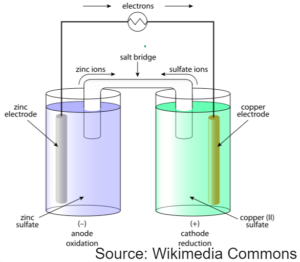
FUEL CELLS
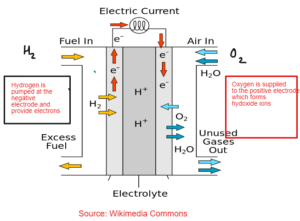 At the Negative Electrode
2H2(g) + 4OH–(aq) 4H2O(l) + 4e–
At the Positive Electrode
O2 + 2H2O + 4e– 4 OH–(aq)
Overall – 2H2(g) + O2 (g) 2H2O(l)
Rates of Reaction and Energy Cha-merged
At the Negative Electrode
2H2(g) + 4OH–(aq) 4H2O(l) + 4e–
At the Positive Electrode
O2 + 2H2O + 4e– 4 OH–(aq)
Overall – 2H2(g) + O2 (g) 2H2O(l)
Rates of Reaction and Energy Cha-merged
Restricted download
×- No harmful gases or waste product is produced
- Waste product is only water so no problem to the environment or disposing off the waste product.
- Do not needs recharging
- Hydrogen is a flammable Gas
- Production of hydrogen depends on non renewable resources.
- Hydrogen being a gas is difficult to store and transport
- Storing and transport of hydrogen involves énergy which comes from fossils fuel thereby it contribute indirectly to -global warming.
Key terms
Exothermic Reaction – The reaction which gives out heat to the surroundings. Example: Respiration or Combustion Endothermic Reaction – The reactions which taken in heat from the surrounding. Example: Photosynthesis or Thermal decomposition Reaction Profile – Diagramatic representation showing the relative energies of reactants and products in a reaction. Activation – Minimum energy required to start a reaction. Bond Energy – Heat energy contained in a bond between two atoms. Chemical Cells – A device that converts chemical energy into electrical energy. Fuel Cells – A chemical cells that uses a reaction between hydrogen and oxygen to form water and energy. Batteries – collection of cells. Label the reaction profile and classify it as Exothermic or Endothermic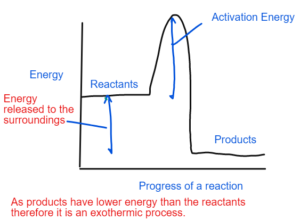
Draw Energy profile diagram of endothermic reaction
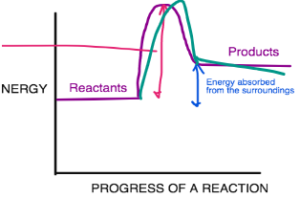
Give two application of exothermic and endothermic reaction
- Exothermic : Self heating cans and hand warmers
- Endothermic: Ice packs, self cooling cans
State the advantages and disadvantages of fuel cell.
ADVANTAGES- No harmful gases or waste product is produced
- Waste product is only water so no problem to the environment or disposing off the waste product.
- Do not needs recharging
-
- Hydrogen is a flammable Gas
- Production of hydrogen depends on non renewable resources.
- Hydrogen being a gas is difficult to store and transport
- Storing and transport of hydrogen involves energy which comes from fossils fuel thereby it contribute indirectly to global warming.
RATE OF REACTION
- In a reaction, the concentration of reactants decreases with time
- In a reaction, the concentration of products increases with time.

- a) Weigh the mass of the reactants at different time interval and plot the graph.
- b) If the products are gas, we can measure the volume of gas evolved at different time intervals
- c) If the precipitation reaction, we can measure absorbance value.
COLLISSION THEORY
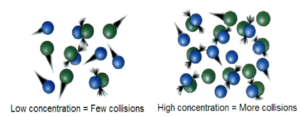 For a reaction to take place, the three important things are required.
For a reaction to take place, the three important things are required.
COLLISIONS
- For the reactions to take place the particles should collide or bump into each other.
ACTIVATION ENERGY (SUCCESSFULL COLLISIONS)
- The particles should collide with the minimum energy required to start the reaction- Activation Energy.
- The collision with the energy equal to or greater than activation energy is successful collision.
CORRECT ORIENTATION
- The particles should have correct orientation for the reaction to take place.
FACTORS AFFECTING RATE OF REACTION
| FACTOR | EFFECT | EXPLANATIONS |
| SURFACE AREA | With increase in surface area the rate of reaction increases Powdered reactants react faster. | Greater the surface area or surface area to volume ratio more particles will be exposed and reactants have greater chance of colliding increasing the rate of reaction. |
| TEMPERATURE | With increase in temperature the reaction rate increases. | With increase in temperature; the particles gain kinetic energy They collide more frequency Greater the collision greater are the chances of successful collisions Also as the energy increases more particles have energy equal or greater than activation energy increasing the rate of a reaction |
| CONCENTRATION OF REACTANTS | With increase in concentration of reactant the reaction rate Increases. | Increasing the concentration increases more particles in the given volume More the particles more the chance of collisions Greater the collision greater the chance of successful collision increasing the rate of the reaction. |
| PRESSURE | With increase in pressure the rate of reaction of the gaseous reactants increases. | Increasing the pressure increases the rate of the reaction as there will be more particles in a lesser volume. So they bump into each other more increasing the rate of the reaction |
| CATALYST | With the use of catalyst the rate of reaction increases. | Catalyst increases the rate of the reaction by providing the alternative route that works by lowering the activation energy. So there are more number of particles with energy equal to activation energy increasing the rate of the reaction. |
CATALYSTS
- Catalysts increases the rate of the reaction by providing an alternative route
- The alternative route lowers the activation energy
- As the activation energy is lowered there are more number of particles having energy equal to or greater than the activation energy increasing the rate of the reaction.
- Required in small quantity and is regenerated after the reaction.
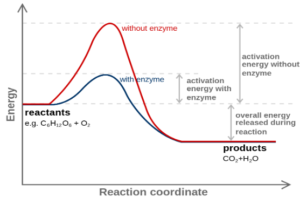 Example
Example
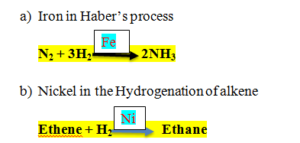 The catalysts help those reactions to carry out at a lower temperature which require very high temperature so saves us on energy and electricity costs.
Baneer 6
The catalysts help those reactions to carry out at a lower temperature which require very high temperature so saves us on energy and electricity costs.
Baneer 6
REVERSIBLE REACTION
Reactions that proceed both in forward and reverse direction. Eg – N2(g) + 3H2(g) ⇌ 2NH3(g)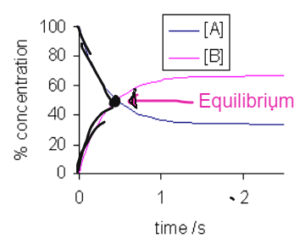 At the start the concentration of the reactants decreases. The reactants decreases and the concentration of products start to increase.
A ⇌ B
There comes a point where concentration of reactants and the products are same as the rate of appearance of products and rate of disappearance of reactants is the same. That point is the equilibrium point.
Banner 7
At the start the concentration of the reactants decreases. The reactants decreases and the concentration of products start to increase.
A ⇌ B
There comes a point where concentration of reactants and the products are same as the rate of appearance of products and rate of disappearance of reactants is the same. That point is the equilibrium point.
Banner 7
DYNAMIC EQUIBRIUM
- When rate of forward reaction is equal to the rate of reverse reaction.
- The reactions does not stop at equilibrium. The reactions takes place with the same rate in both the direction so overall we see no change.
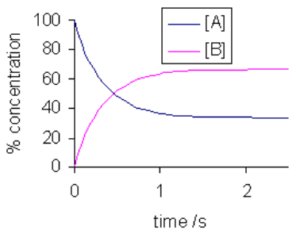
CONDITIONS FOR DYNAMIC EQUILBRIUM
- a) It has to be closed system. Nothing should leave or enter the system.
- b) The rate of forward reaction should be equal to the rate of reverse reaction.
Le Chattelier’s Principle
When the system in equilibrium is subject to a change, the equilibrium is moved to a direction to counteract the chance. Concentration ⇌ N2(g) + 3H2(g) ⇌ 2NH3(g) Forward direction ammonia is made in the reverse direction nitrogen and hydrogen are used up. Add nitrogen Right Add hydrogen Right Add ammonia Left Remove Ammonia Right So in habers process nitrogen and hydrogen are continously added and unreacted are recycled and ammonia is removed as soon as it is formed. Pressure- More the gas molecules more the pressure.
- Less the pressure less the gas molecules.
- Increasing pressure = Less gas side = Right
- Decreasing pressure: = more gas side = Left
- So high pressure is required for manufacture of ammonia.
Temperature and Equilbrium
- If ΔH is negative the forward reaction is exothermic and produces heat.
- If the forward is exothermic the reverse is endothermic and vice versa.
- Forward reaction is exothermic produces heat. Reverse reaction is endothermic and takes in heat.
- Increase in temperature will shift the equilibrium side which is left and decrease in temperature will shift to more heat side which is right.
KEY TERMS
-
- a) Rate of a reaction – It is the decrease in the concentration of reactants per unit time, or the increase in the concentration of products per unit time,
- b) Collision Theory – For the reactions to take place the particles should collide or bump into each other. Low concentration = few collisions. High Concentration = more collisions.
- c) Activation Energy – the minimum energy required to start the reaction.
- d) Catalysts – A catalyst is a substance that changes the speed of a chemical reaction without chemically altering it at the end of the reaction.
- e) Reversible Reaction – Reactions that proceed both in forward and reverse direction.
- f) Dynamic Equilibrium – When rate of forward reaction is equal to the rate of reverse reaction.
- g) Le Chatellier’s Principle – When the system in equilibrium is subject to a change, the equilibrium is moved to a direction to counteract the chance.
- h) Exothermic – Produces Heat
- i) Endothermic – Takes in Heat
Disclaimer:
I have tried my level best to cover the maximum of your specification. But this is not the alternative to the textbook. You should cover the specification or the textbook thoroughly. This is the quick revision to help you cover the gist of everything. In case you spot any errors then do let us know and we will rectify it. References: BBC Bitesize Wikipedia Wikimedia Commons Image Source: Wikipedia Wikimedia Commons Flickr PixabayQuestion by Topic
Make sure you have watched the above videos and are familiar with the key definations before trying these questions. It is also good to time yourself while doing these questions so that you can work on the speed as well.
Rates of Reaction and Energy Changes
- Exothermic & Endothermic Reactions 1 MS
- Exothermic & Endothermic Reactions 1 QP
- Exothermic & Endothermic Reactions 2 MS
- Exothermic & Endothermic Reactions 2 QP
- Exothermic & Endothermic Reactions 3 MS
- Exothermic & Endothermic Reactions 3 QP
Rates And Equilibrium
- Rate of Reaction 1 MS
- Rate of Reaction 1 QP
- Rate of Reaction 2 MS
- Rate of Reaction 2 QP
- Rate of Reaction 3 MS
- Rate of Reaction 3 QP
- Reversible Reactions & Dynamic Equilibrium 1 MS
- Reversible Reactions & Dynamic Equilibrium 1 QP
- Reversible Reactions & Dynamic Equilibrium 2 MS
- Reversible Reactions & Dynamic Equilibrium 2 QP
- Reversible Reactions & Dynamic Equilibrium 3 MS
- Reversible Reactions & Dynamic Equilibrium 3 QP
